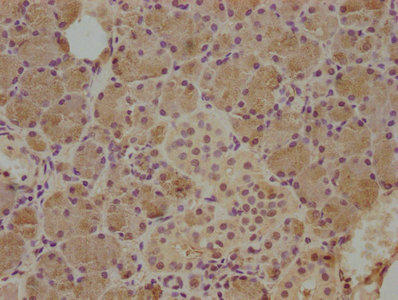Description
| Antibody Name: | CST5 Antibody (PACO63283) |
| Antibody SKU: | PACO63283 |
| Size: | 50ul |
| Host Species: | Rabbit |
| Tested Applications: | ELISA, IHC |
| Recommended Dilutions: | ELISA:1:2000-1:10000, IHC:1:500-1:1000 |
| Species Reactivity: | Human |
| Immunogen: | Recombinant Human Cystatin-D protein (21-142AA) |
| Form: | Liquid |
| Storage Buffer: | Preservative: 0.03% Proclin 300 Constituents: 50% Glycerol, 0.01M PBS, pH 7.4 |
| Purification Method: | >95%, Protein G purified |
| Clonality: | Polyclonal |
| Isotype: | IgG |
| Conjugate: | Non-conjugated |
 | IHC image of PACO63283 diluted at 1:500 and staining in paraffin-embedded human salivary gland tissue performed on a Leica BondTM system. After dewaxing and hydration, antigen retrieval was mediated by high pressure in a citrate buffer (pH 6.0). Section was blocked with 10% normal goat serum 30min at RT. Then primary antibody (1% BSA) was incubated at 4°C overnight. The primary is detected by a biotinylated secondary antibody and visualized using an HRP conjugated SP system. |
| Background: | Cysteine proteinase inhibitor that possibly plays a protective role against proteinases present in the oral cavity. The order of preference for inhibition is cathepsin S > cathepsin H > cathepsin L > cathepsin B. |
| Synonyms: | Cystatin-D (Cystatin-5), CST5 |
| UniProt Protein Function: | CST5: Cysteine proteinase inhibitor that possibly plays a protective role against proteinases present in the oral cavity. The order of preference for inhibition is cathepsin S > cathepsin H > cathepsin L > cathepsin B. Belongs to the cystatin family.Protein type: Secreted, signal peptide; SecretedChromosomal Location of Human Ortholog: 20p11.21Cellular Component: extracellular regionMolecular Function: protein binding; cysteine protease inhibitor activity |
| UniProt Protein Details: | |
| NCBI Summary: | The cystatin superfamily encompasses proteins that contain multiple cystatin-like sequences. Some of the members are active cysteine protease inhibitors, while others have lost or perhaps never acquired this inhibitory activity. There are three inhibitory families in the superfamily, including the type 1 cystatins (stefins), type 2 cystatins and the kininogens. The type 2 cystatin proteins are a class of cysteine proteinase inhibitors found in a variety of human fluids and secretions. The cystatin locus on chromosome 20 contains the majority of the type 2 cystatin genes and pseudogenes. This gene is located in the cystatin locus and encodes a protein found in saliva and tears. The encoded protein may play a protective role against proteinases present in the oral cavity. [provided by RefSeq, Jul 2008] |
| UniProt Code: | P28325 |
| NCBI GenInfo Identifier: | 19882256 |
| NCBI Gene ID: | 1473 |
| NCBI Accession: | NP_001891.2 |
| UniProt Secondary Accession: | P28325,Q5JRF5, Q9UCA0 |
| UniProt Related Accession: | P28325 |
| Molecular Weight: | 16,080 Da |
| NCBI Full Name: | cystatin-D |
| NCBI Synonym Full Names: | cystatin D |
| NCBI Official Symbol: | CST5 |
| NCBI Official Synonym Symbols: | |
| NCBI Protein Information: | cystatin-D; cystatin 5; cystatin-5; cysteine-proteinase inhibitor |
| UniProt Protein Name: | Cystatin-D |
| UniProt Synonym Protein Names: | Cystatin-5 |
| Protein Family: | Cystatin |
| UniProt Gene Name: | CST5 |
| UniProt Entry Name: | CYTD_HUMAN |






